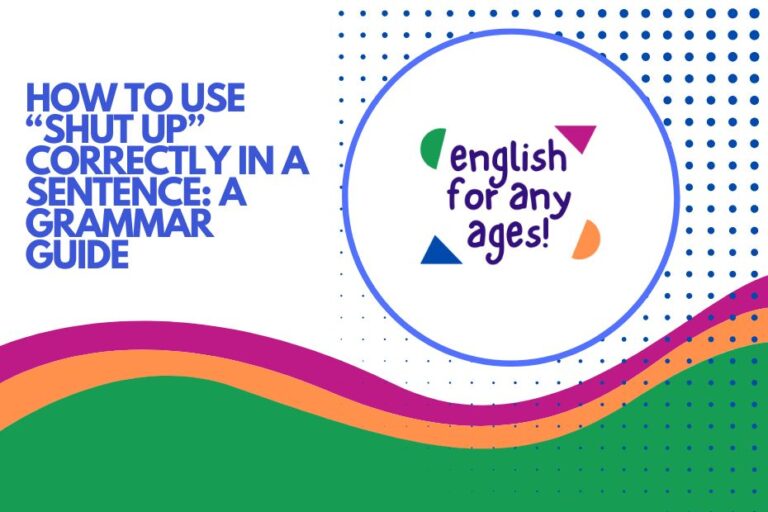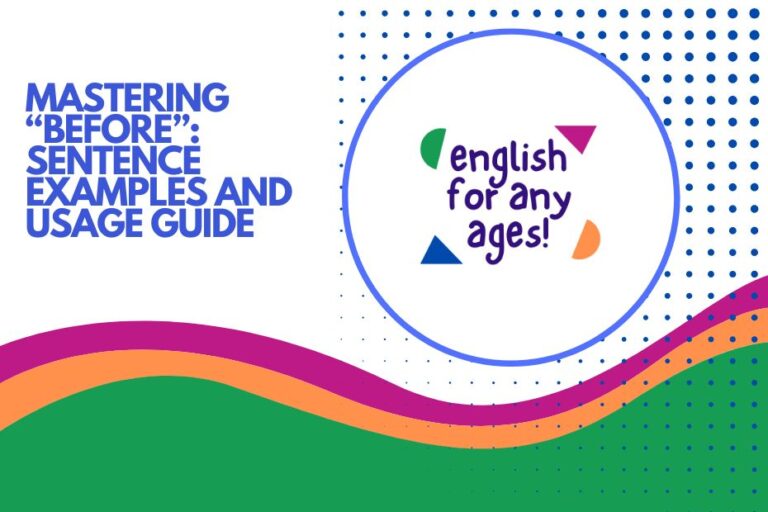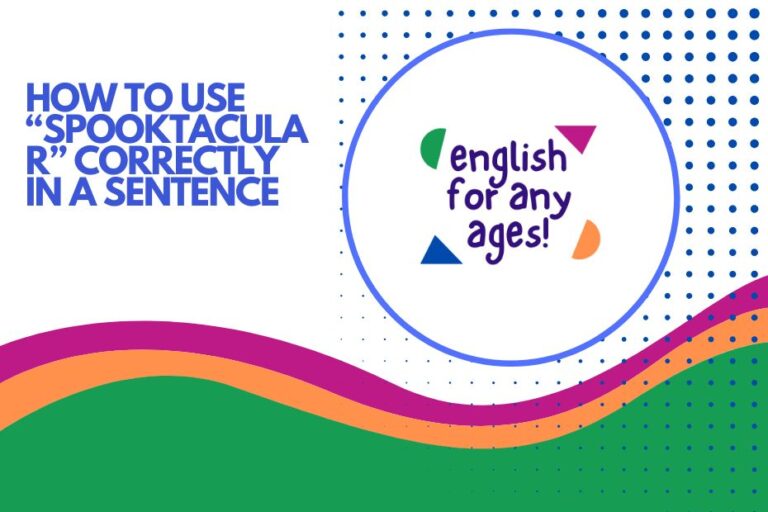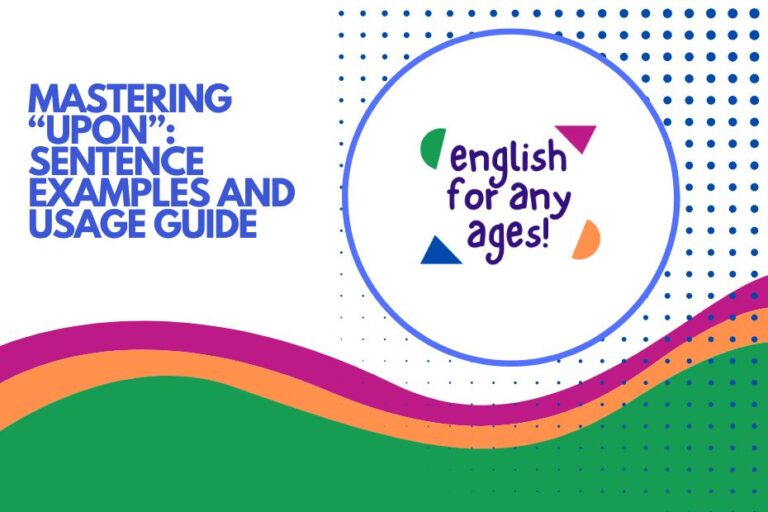Mastering ‘Beneath’: Sentence Examples and Usage Guide
The preposition “beneath” is a versatile word in the English language, used to describe spatial relationships, hierarchical positions, and even abstract concepts. Understanding its nuances is crucial for precise and effective communication.
This article provides a comprehensive guide to using “beneath” correctly, complete with definitions, structural breakdowns, diverse examples, usage rules, common mistakes, practice exercises, and advanced applications. Whether you’re a beginner or an advanced learner, this guide will help you master the art of using “beneath” in your writing and speech.
This detailed exploration of “beneath” is designed for English language learners of all levels, from beginners seeking a foundational understanding to advanced speakers aiming to refine their usage. By delving into its various contexts and applications, you’ll gain the confidence to use “beneath” accurately and effectively, enriching your overall command of the English language.
Table of Contents
- Introduction
- Definition of “Beneath”
- Structural Breakdown
- Types and Categories of Usage
- Spatial Relationships
- Hierarchical Position
- Abstract Concepts
- Examples of “Beneath” in Sentences
- Spatial Relationship Examples
- Hierarchical Position Examples
- Abstract Concept Examples
- Usage Rules for “Beneath”
- Formal vs. Informal Usage
- Synonyms and Alternatives
- Common Mistakes When Using “Beneath”
- Practice Exercises
- Exercise 1: Fill in the Blanks
- Exercise 2: Sentence Correction
- Exercise 3: Sentence Writing
- Advanced Topics
- “Beneath” in Literature
- Idiomatic Expressions with “Beneath”
- Frequently Asked Questions
- Conclusion
Definition of “Beneath”
The word “beneath” functions primarily as a preposition in English grammar. It indicates a position that is directly below or underneath something else.
However, its usage extends beyond simple spatial relationships. “Beneath” can also denote a lower rank, status, or condition, or even describe something hidden or concealed.
The word carries a slightly more formal tone compared to its synonym “under.”
Classifying “beneath” strictly as a preposition, it connects a noun or pronoun (the object of the preposition) to another word in the sentence, establishing a relationship between them. This relationship can be spatial, hierarchical, or conceptual, depending on the context.
The function of “beneath” is to specify the relative position, status, or condition of one thing in relation to another. For instance, in the sentence “The cat is beneath the table,” “beneath” specifies the cat’s location relative to the table.
In “He felt it was beneath him to argue with such a person,” “beneath” describes his perceived status relative to the other person.
Structural Breakdown
The basic structure involving “beneath” in a sentence is: Subject + Verb + Beneath + Object. The object is the noun or pronoun that “beneath” relates to the subject. Let’s break this down further:
- Subject: The person, place, or thing that performs the action or is being described.
- Verb: The action word or state of being.
- Beneath: The preposition indicating the relationship.
- Object: The noun or pronoun that “beneath” refers to.
For example, in the sentence “The roots spread beneath the soil,” the subject is “the roots,” the verb is “spread,” “beneath” is the preposition, and “the soil” is the object. This structure clearly shows how “beneath” connects the roots to their location in relation to the soil.
The prepositional phrase “beneath + object” often functions as an adverbial phrase, modifying the verb by providing information about location, manner, or circumstance. For instance, “The treasure lies beneath the old oak tree” tells us *where* the treasure lies.
Types and Categories of Usage
“Beneath” can be categorized into three primary types of usage:
Spatial Relationships
This is the most literal and common usage of “beneath,” indicating that something is physically located under something else. Examples include: “The submarine traveled beneath the waves,” or “The miners worked beneath the surface of the earth.” This usage emphasizes the physical proximity and relative position of objects.
Hierarchical Position
Here, “beneath” implies a lower rank, status, or social standing. For example: “He considered such tasks beneath his dignity,” or “The enlisted soldiers were beneath the officers in the military hierarchy.” This usage highlights differences in authority and importance.
Abstract Concepts
In this case, “beneath” describes something hidden, concealed, or underlying. Examples include: “Beneath the surface of her anger lay a deep sadness,” or “Beneath his calm exterior, he was incredibly nervous.” This usage explores the hidden layers of emotions, motives, or situations.
Examples of “Beneath” in Sentences
To illustrate the various uses of “beneath,” here are several examples categorized by the types discussed above. These examples will provide a clear understanding of how to use “beneath” correctly in different contexts.
Each table contains a variety of sentences showcasing the different nuances of the preposition “beneath”.
Spatial Relationship Examples
The following table provides examples of “beneath” used to describe spatial relationships. Notice how “beneath” indicates a physical position directly below something else.
| # | Sentence |
|---|---|
| 1 | The cat hid beneath the bed. |
| 2 | The old pipes ran beneath the city streets. |
| 3 | The roots of the tree extended far beneath the ground. |
| 4 | A hidden stream flowed beneath the forest floor. |
| 5 | The submarine quietly moved beneath the waves. |
| 6 | The treasure was buried beneath layers of sand. |
| 7 | The workers toiled beneath the construction site. |
| 8 | The lost city lay beneath the ocean’s surface. |
| 9 | The soldiers took cover beneath the bridge. |
| 10 | The warmth of the earth is beneath our feet. |
| 11 | The foundation of the building extends beneath the surface. |
| 12 | A whole network of tunnels exists beneath the city. |
| 13 | The lava flowed beneath the hardened crust. |
| 14 | The divers explored the wreckage beneath the sea. |
| 15 | The secrets were hidden beneath the floorboards. |
| 16 | The worms burrowed beneath the soil. |
| 17 | The children crawled beneath the table during the game. |
| 18 | The ancient ruins lay beneath the modern city. |
| 19 | The cables were laid beneath the road surface. |
| 20 | The plants struggled to grow beneath the dense canopy. |
| 21 | The water cascaded beneath the rocks. |
| 22 | The train traveled beneath the mountain. |
| 23 | The pipeline runs beneath the riverbed. |
| 24 | The ants built their colony beneath the old log. |
| 25 | The old well was hidden beneath a layer of stones. |
Hierarchical Position Examples
This table illustrates the use of “beneath” to indicate a lower rank or status. The sentences emphasize a sense of being inferior or unworthy.
| # | Sentence |
|---|---|
| 1 | He felt it was beneath him to clean the bathroom. |
| 2 | She considered such menial tasks beneath her dignity. |
| 3 | The manager thought it was beneath her to answer phones. |
| 4 | He wouldn’t lower himself; he saw it as beneath him. |
| 5 | She deemed gossiping about others as beneath her. |
| 6 | He believed begging for money was beneath his pride. |
| 7 | She regarded lying as beneath her moral standards. |
| 8 | The aristocrat thought manual labor was beneath him. |
| 9 | He considered cheating in a game beneath his principles. |
| 10 | She found arguing with fools beneath her time. |
| 11 | He considered accepting charity beneath his capabilities. |
| 12 | She thought that stooping to their level was beneath her. |
| 13 | He wouldn’t engage in such petty arguments; it was beneath him. |
| 14 | She felt that compromising her values was beneath her. |
| 15 | He refused to participate in such vulgar behavior, considering it beneath him. |
| 16 | She saw herself as someone for whom such dishonesty was beneath consideration. |
| 17 | He thought that groveling for forgiveness was beneath his stature. |
| 18 | She deemed it beneath her to engage in such trivial pursuits. |
| 19 | He felt that betraying his friends was beneath his honor. |
| 20 | She regarded working for such a corrupt company as beneath her. |
| 21 | He considered lowering his standards beneath his integrity. |
| 22 | She thought that participating in such a farce was beneath her. |
| 23 | He deemed it beneath him to associate with such unsavory characters. |
| 24 | She felt that compromising her principles was beneath her. |
| 25 | He considered accepting unfair advantages beneath his ethical code. |
Abstract Concept Examples
The following table provides examples where “beneath” is used to describe hidden or underlying feelings, motives, or situations. It emphasizes the unseen aspects of a subject.
| # | Sentence |
|---|---|
| 1 | Beneath her smile, she felt incredibly sad. |
| 2 | Beneath his anger, there was a layer of fear. |
| 3 | Beneath the calm facade, he was deeply worried. |
| 4 | Beneath the surface of their friendship, tension simmered. |
| 5 | Beneath his tough exterior, he was a gentle soul. |
| 6 | Beneath the noise, there was a quiet sense of peace. |
| 7 | Beneath the words, there was a hidden meaning. |
| 8 | Beneath the chaos, there was a sense of order. |
| 9 | Beneath the confidence, he had self-doubt. |
| 10 | Beneath the enthusiasm, she felt tired. |
| 11 | Beneath the layers of makeup, her natural beauty shone. |
| 12 | Beneath the criticism, there was a grain of truth. |
| 13 | Beneath the laughter, she hid her pain. |
| 14 | Beneath the jokes, there was a serious message. |
| 15 | Beneath the surface of the water, danger lurked. |
| 16 | Beneath the veneer of civility, hostility brewed. |
| 17 | Beneath the facade of happiness, she was heartbroken. |
| 18 | Beneath the layers of history, secrets were buried. |
| 19 | Beneath the calm sea, strong currents swirled. |
| 20 | Beneath the noise of the city, nature persisted. |
| 21 | Beneath the apparent success, there were many struggles. |
| 22 | Beneath the political rhetoric, the people’s needs were ignored. |
| 23 | Beneath the technological progress, the environment suffered. |
| 24 | Beneath the commercialism, the true spirit of the holiday was lost. |
| 25 | Beneath the scientific advancements, ethical questions remained. |
Usage Rules for “Beneath”
Using “beneath” correctly involves understanding its formal tone and choosing appropriate synonyms when necessary. Here are some key usage rules to consider:
- Spatial Relationships: Use “beneath” to indicate a direct, physical position below something else.
- Hierarchical Contexts: Employ “beneath” to express a sense of lower status or unworthiness.
- Abstract Meanings: Utilize “beneath” to suggest hidden feelings, motives, or underlying situations.
Formal vs. Informal Usage
“Beneath” is generally considered more formal than “under.” In casual conversation, “under” is often preferred. However, in formal writing or speaking, “beneath” can add a touch of elegance and precision.
Consider the context and audience when choosing between the two.
Synonyms and Alternatives
Several synonyms and alternatives can be used in place of “beneath,” depending on the context. These include:
- Under: The most common and versatile alternative.
- Underneath: Similar to “under,” but can sometimes emphasize being completely covered.
- Below: Often used for hierarchical or numerical contexts (e.g., “below sea level”).
- Lower than: A more explicit alternative for hierarchical comparisons.
Choosing the right synonym can help you achieve the precise meaning you intend. Consider the specific nuances of each word to make the best choice.
Common Mistakes When Using “Beneath”
Even experienced English speakers sometimes make mistakes when using “beneath.” Here are some common errors to avoid:
| Incorrect | Correct | Explanation |
|---|---|---|
| The dog is beneath the chair from sleeping. | The dog is sleeping beneath the chair. | Correct word order is essential. The prepositional phrase must be properly placed. |
| He felt under him to do that job. | He felt it was beneath him to do that job. | Using “under” instead of “beneath” in a hierarchical context changes the meaning. |
| Beneath of the surface, there are rocks. | Beneath the surface, there are rocks. | The preposition “of” is unnecessary and incorrect after “beneath.” |
| She was hiding under her sadness. | Beneath her sadness, she was hiding something. | Using “beneath” clarifies that sadness is the surface emotion, concealing something else. |
| The river flowed below the bridge. | The river flowed beneath the bridge. | While “below” can work, “beneath” emphasizes direct proximity and physical contact with the underside of the bridge. |
By being aware of these common mistakes, you can avoid them in your own writing and speaking.
Practice Exercises
Test your understanding of “beneath” with these practice exercises. Each exercise focuses on different aspects of using “beneath” correctly.
Answers are provided at the end of each section.
Exercise 1: Fill in the Blanks
Fill in the blanks with the correct preposition: “beneath,” “under,” or “below.”
| # | Sentence | Answer |
|---|---|---|
| 1 | The miners worked far __________ the ground. | beneath |
| 2 | The temperature is __________ freezing. | below |
| 3 | The cat is hiding __________ the sofa. | under |
| 4 | He felt it was __________ him to ask for help. | beneath |
| 5 | __________ his calm demeanor, he was panicking. | Beneath |
| 6 | The submarine traveled __________ the sea. | beneath |
| 7 | The rank __________ captain is lieutenant. | below |
| 8 | The children played __________ the shade of the tree. | under |
| 9 | __________ the surface of the lake, there are many fish. | Beneath |
| 10 | She considered such petty tasks __________ her. | beneath |
Exercise 2: Sentence Correction
Identify and correct the errors in the following sentences.
| # | Incorrect Sentence | Corrected Sentence |
|---|---|---|
| 1 | The book is beneath of the table. | The book is beneath the table. |
| 2 | He felt under to clean the mess. | He felt it was beneath him to clean the mess. |
| 3 | Beneath of her smile, there was sadness. | Beneath her smile, there was sadness. |
| 4 | The tunnel went under the mountain deep. | The tunnel went deep beneath the mountain. |
| 5 | She was beneath from them in social status. | She was beneath them in social status. |
| 6 | He thought it was under him to apologize. | He thought it was beneath him to apologize. |
| 7 | Beneath of the noise, I could hear music. | Beneath the noise, I could hear music. |
| 8 | The treasure lay under layers of dirt. | The treasure lay beneath layers of dirt. (Both correct, but “beneath” is more formal) |
| 9 | The secret was hidden under his tough exterior. | The secret was hidden beneath his tough exterior. |
| 10 | They were standing below the tree. | They were standing beneath the tree. (Both correct, but “beneath” implies closer proximity) |
Exercise 3: Sentence Writing
Write sentences using “beneath” in each of the following contexts:
- Spatial relationship
- Hierarchical position
- Abstract concept
Here are some example answers:
- The roots of the oak tree spread far beneath the surface of the earth.
- The politician considered lying beneath his dignity.
- Beneath his confident exterior, he harbored deep insecurities.
Advanced Topics
For advanced learners, understanding the use of “beneath” in literature and idiomatic expressions can further enhance their command of the language.
“Beneath” in Literature
Authors often use “beneath” to create vivid imagery and convey deeper meanings. In literature, “beneath” can symbolize hidden truths, suppressed emotions, or underlying societal issues.
Analyzing its usage in literary works can provide a greater appreciation of its versatility and impact.
For example, a writer might use “beneath” to describe the hidden darkness lurking beneath a seemingly idyllic setting, foreshadowing impending doom or revealing a character’s inner turmoil. The subtle use of “beneath” adds layers of complexity to the narrative.
Idiomatic Expressions with “Beneath”
While not as common as with “under,” certain idiomatic expressions incorporate “beneath.” Understanding these expressions can help you interpret nuanced meanings and use them effectively in your own communication.
One example, though less frequently used today, is “beneath contempt,” meaning something is so bad it doesn’t even deserve to be hated, only ignored. Recognizing such idioms can enrich your understanding of the English language and allow for more sophisticated expression.
Frequently Asked Questions
- Is “beneath” more formal than “under”?
Yes, “beneath” generally carries a more formal tone than “under.” While both can indicate a position below something else, “beneath” is often preferred in formal writing or speaking to add a touch of elegance and precision.
- Can “beneath” be used in all contexts where “under” is used?
Not always. While many situations allow for interchangeability, “beneath” is more specifically used to denote a direct, physical position or to imply a lower status or hidden meaning. “Under” is more versatile and can be used in a broader range of contexts.
- What are some common synonyms for “beneath”?
Common synonyms include “under,” “underneath,” “below,” and “lower than.” The best choice depends on the specific context and the nuance you want to convey.
- How does the meaning of a sentence change if I use “beneath” instead of “under”?
The change can be subtle. “Beneath” often adds a layer of formality or emphasizes the directness of the physical position or the depth of a hidden meaning. In hierarchical contexts, it clearly indicates a lower status or unworthiness.
- Is it correct to say “beneath of” something?
No, this is incorrect. The correct phrasing is simply “beneath” followed by the object. The preposition “of” is unnecessary and grammatically incorrect in this context.
- Can “beneath” be used metaphorically?
Yes, “beneath” is often used metaphorically to describe hidden or underlying feelings, motives, or situations. For example, “Beneath his calm exterior, he was incredibly nervous” uses “beneath” to describe a hidden emotional state.
- What is the difference between ‘beneath’ and ‘below’?
While both indicate a lower position, ‘beneath’ often implies direct contact or close proximity, whereas ‘below’ can refer to a more general lower position, including hierarchical or numerical order. For example, ‘The cat is beneath the table’ suggests the cat is directly under it, whereas ‘The temperature is below freezing’ indicates a numerical value.
- How can I improve my usage of “beneath” in writing?
Pay attention to the context and your intended meaning. Consider whether you want to emphasize a direct physical position, a lower status, or a hidden aspect. Read examples of “beneath” used in various contexts to develop a feel for its nuances. Practice writing sentences using “beneath” in different ways.
Conclusion
Mastering the use of “beneath” can significantly enhance your ability to communicate effectively in English. By understanding its definition, structural breakdown, types of usage, and common mistakes, you can confidently incorporate it into your writing and speech.
Remember that “beneath” is a formal preposition that can add sophistication to your language when used correctly.
To further improve your skills, practice using “beneath” in various contexts, pay attention to its usage in literature and everyday conversation, and don’t hesitate to consult dictionaries and grammar resources. With consistent effort, you can master the nuances of “beneath” and elevate your overall command of the English language.






